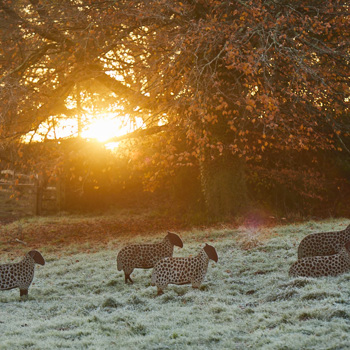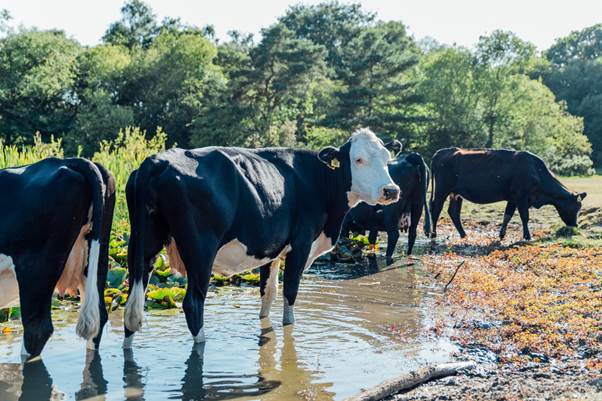
A Forager’s Winter Larder
Hear from Lime Wood’s resident forager, Sammie, about how to embrace the seasons through wild harvesting, herbal preparations, and creating your own winter larder.

By Sammie Longhorn, Lime Wood’s resident forager (@the_hedgerow_yogi)
Lime Wood is lucky enough to be a few short minutes from Lyndhurst, the administrative heart of the New Forest and considered, by some, to be its ancient capital. The New Forest is a stunning patchwork of ecosystems, including coastlines, rivers and heaths, and some of the rarest habitats on earth, such as ancient woodlands and wetlands. The forest boasts one of the highest concentrations of ancient trees in Western Europe. An incredible array of plants flourish here that were traditionally harvested for food, medicine and more, but as we will learn, humans are certainly not the forest’s most successful foragers.
The landscape and habitat are merely one unique aspect of The New Forest. We have a rich and distinct culture and heritage too. Commoning is a practice that heavily influences the ecology of the forest. Dictated by the property owned, Commoners are bestowed the right to turn their livestock out to graze. This is a way of life and tradition that has persisted for many generations. Ponies, donkeys and cows are turned out to roam and graze, sustaining themselves on a diet of grasses, heather and fallen apples. As the New Forest ponies are so well adapted to this environment, they can also eat gorse and holly too, far too robust and spiny for other livestock.

Autumn heralds the arrival of the Pannage pigs, whereby the pigs are turned out to eat the forest’s acorn and nut harvests. The date fluctuates each year, determined by the New Forest Verderers, an ancient body governing the plant life of the New Forest. The livestock of the forest are similarly the responsibility of the Agisters. To learn more about these ancient traditions you can visit the Verderer Hall on Lyndhurst High Street, occupying the same spot as the original 1388 building.
When people think of foraging in the New Forest, their mind turns immediately to fungi which flourish here. The soil type and climate make it one of the best habitats on the whole of Great Britain and we enjoy a profusion of varieties of mushrooms. However, Forestry England state that fungi picking in the New Forest is illegal.
With regards to other herbs and plants, The Countryside Act of 1968 allows foraging for personal use, but the New Forest’s status as a National Park and a Site of Scientific Special Interest mean that it is afforded the highest level of legal protection when it comes to foraging, in addition to several ancient byelaws. Therefore, if you want to connect to the plants of this amazing area I would consider foraging in similar habitats on the periphery of the forest, but not in the New Forest proper.

My favourite harvests that can be found here at this time of year are the rosehips, hawthorns and elderberries which I blend into an immune-boosting syrup for the approaching winter. Since my experience of eating only wild and foraged food for three months, my love of wild nuts and seeds is greater than ever before. Last year was a terrible harvest for acorns, beech nuts and sweet chestnuts and this year I intend to really make the most of what is promising to be a bumper year. These will then be processed and ground into flour for wild biscuits and pancakes.
Two plants that are quintessentially of the New Forest, and thus dear to my heart, are the heather and the gorse. Although these are underused in cooking and medicine, they were once highly prized by the Romany Gypsies who enjoyed a nomadic and traditional lifestyle here. On a warm day, gorse flower has a surprisingly tropical, coconut-like flavour so is great in wild drinks, syrup, tea, or even infused in gin. Gorse wood burns hot and long so was the favoured fuel for the ancient forest residents to burn when making bread. Heather was similarly used for thatching and basket making or dried and blended into an anti-inflammatory and detoxifying tea.
As is so often the case though, the best medicine of all can be to get out into these wild spaces and allow ourselves to be moved by their beauty, and here in the New Forest, we are spoilt for choice.
Want to join Sammie on one of her foraging experiences? Click here to view upcoming dates and availability: Event Details | Lime Wood
Want to keep up to date with Sammie’s foraging activities? Visit her website: The Hedgerow Yogi

Hear from Lime Wood’s resident forager, Sammie, about how to embrace the seasons through wild harvesting, herbal preparations, and creating your own winter larder.
There’s a special kind of magic at Curated during the festive season. To help inspire your Christmas gifting, our team has gathered a few of their favourite pieces this season.

Delve beneath the surface (literally) to explore the fascinating world of microbiomes with Peigin Crowley, founder of Ground Wellbeing